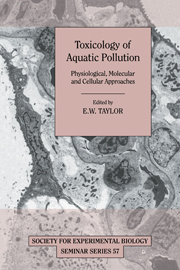Book contents
- Frontmatter
- Contents
- List of contributors
- Preface
- Water chemistry at the gill surfaces of fish and the uptake of xenobiotics
- Bioaccumulation of waterborne 1,2,4,5-tetrachlorobenzene in tissues of rainbow trout
- Dietary exposure to toxic metals in fish
- The physiology and toxicology of zinc in fish
- Lethal and sub-lethal effects of copper upon fish: a role for ammonia toxicity?
- The physiological status of brown trout exposed to aluminium in acidic soft waters
- Physiological and metabolic costs of acclimation to chronic sub-lethal acid and aluminium exposure in rainbow trout
- Physiological effects of nitrite in teleosts and crustaceans
- Metallothioneins in fish: induction and use in environmental monitoring
- Oestrogenic substances in the aquatic environment and their potential impact on animals, particularly fish
- Effect of genetic toxicants in aquatic organisms
- In vitro toxicology of aquatic pollutants: use of cultured fish cells
- Principles governing the use of cytochrome P4501A1 measurement as a pollution monitoring tool in the aquatic environment
- Index
Effect of genetic toxicants in aquatic organisms
Published online by Cambridge University Press: 20 May 2010
- Frontmatter
- Contents
- List of contributors
- Preface
- Water chemistry at the gill surfaces of fish and the uptake of xenobiotics
- Bioaccumulation of waterborne 1,2,4,5-tetrachlorobenzene in tissues of rainbow trout
- Dietary exposure to toxic metals in fish
- The physiology and toxicology of zinc in fish
- Lethal and sub-lethal effects of copper upon fish: a role for ammonia toxicity?
- The physiological status of brown trout exposed to aluminium in acidic soft waters
- Physiological and metabolic costs of acclimation to chronic sub-lethal acid and aluminium exposure in rainbow trout
- Physiological effects of nitrite in teleosts and crustaceans
- Metallothioneins in fish: induction and use in environmental monitoring
- Oestrogenic substances in the aquatic environment and their potential impact on animals, particularly fish
- Effect of genetic toxicants in aquatic organisms
- In vitro toxicology of aquatic pollutants: use of cultured fish cells
- Principles governing the use of cytochrome P4501A1 measurement as a pollution monitoring tool in the aquatic environment
- Index
Summary
Introduction
In recent years, attention has been given to investigating the occurrence of genotoxic agents in the aquatic environment. The increasing concern of the general public and of governments for the welfare of the natural environment has warranted an upsurge in such studies which have often been designed to investigate the cause of tumour production in various aquatic organisms in areas of raised pollution status. A causal relationship between pollutants and cancer in aquatic organisms is by no means proven. There are studies, however, that raise considerable concern. For example, results of a series of experiments on the association between sediment pollutants and hepatic tumours in English sole (Parophrys vetulus) of the Puget Sound, USA, have provided convincing evidence of a causative relationship (see Stein et al, 1990). Similarly, although much less is known of the situation in invertebrates, experimental studies have demonstrated chemical induction of tumours in the oyster (Crassostrea virginica) by a mixture of poly cyclic aromatic hydrocarbons (PAHs), polychlorobiphenyls (PCBs), amines and metals (Gardner, Pruell & Malcolm, 1992), and in planarians by a range of mammalian carcinogens (Schaeffer, 1993). The development of new, sensitive, molecular techniques, so-called biomarkers (Livingstone, 1993), for assessing genetic toxicity have also played an important role in driving the new era of environmental monitoring.
Why should we be concerned about exposure of organisms to mutagens? An increased tumour incidence is of concern, not only regarding the organisms directly exposed but also regarding human beings exposed to bioaccumulated chemicals via the diet.
- Type
- Chapter
- Information
- Toxicology of Aquatic PollutionPhysiological, Molecular and Cellular Approaches, pp. 225 - 252Publisher: Cambridge University PressPrint publication year: 1996
- 5
- Cited by

